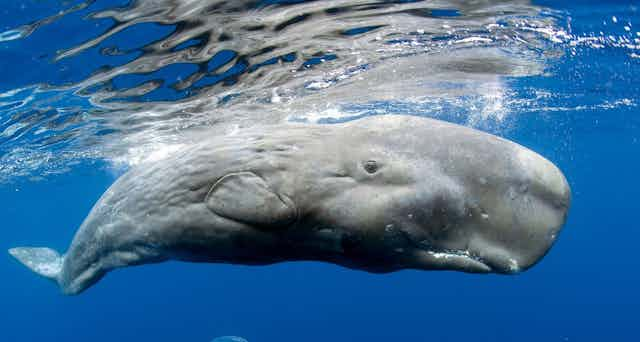A sperm whale’s “click” is the loudest sound produced by any animal – and it has an identifying dialect. In fact, according to a study published in Nature Communications, the whales aren’t born with different vocal chords or a bit of the sea particularly suited to a certain kind of click. They simply acquire their dialects from one another in the same way you or I might have taken on our parents’ accent – by copying what they hear.
Sperm whales aren’t the only animals who learn like this. I have spent time with bottlenose dolphins, for instance, in many different locations around the world. One thing that has always struck me is that while these dolphins tend to do the same thing – such as hunt fish or play together – the way they do this can differ quite drastically between populations.
In the late 1990s, Andy Whiten best articulated this “feeling” that field biologists have had for a long time in his study of chimpanzees, the first systematic look at behavioural differences between populations.
Whiten and colleagues showed different groups of chimps did the same thing in drastically different ways, for example the way they used tools to catch ants. These differences spanned the whole activity repertoire of chimpanzees and the authors posited that the best way to explain this variation was simple: chimpanzees have culture.
Are animals born cultured?
This discovery started the “culture wars”, largely between animal behaviourists and anthropologists, a debate which raised the question of when we could talk about cultural variations in animal behaviour.
A scientific approach is to make predictions we can challenge with experiments and observations. For animals to have culture, the observed differences must not be explained by any other mechanisms. The first mechanism is simply genetics: these differences could be “hardwired” in the genetic differences between populations. The second mechanism is landscape differences: for example, a monkey will not be able to crack nuts with a rock if there are no rocks to hand. So the observed differences cannot be caused by the lack of opportunity or need caused by the animal’s environment.
Since Whiten’s work, many people have registered differences in behaviour in a wide range of species, which we cannot attribute to these two factors. For example, the detailed genetic work of Michael Kruetzen and his team has helped to dispel the “hardwiring” argument for tool use in dolphins.
Cultural differences are something we pick up from others and pass on, it is a social process. We acquire cultural habits from our social circles and importantly by not being exposed to the way other groups do the same thing. So in order for behavioural differences to be culture, they need to be socially learned. Social learning is again a process we now know exist in many of the species we suspect have culture.
Culture can also be a hindrance to forming social relationships; in our case the simple language barrier is often limiting the social interactions individuals can have. So culture and social structure are intertwined in some ways: you are more likely to pick up the habits of individuals with whom you interact; and the more you pick up these habits, the harder it becomes to interact with others outside your group.
One big ocean – so why the different clans?
Back to whales. In the latest study, Maurício Cantor, Hal Whitehead and their colleagues show that cultural difference is the best way to explain why sperm whales live in multilevel societies. This social structure is best described as having several levels of organisation. In the case of sperm whales, individuals live with their extended families, which belong to clans. Whitehead, along with his colleagues, has elegantly shown over the past two decades that it is hard to explain the differences we observed between sperm whale clans without invoking culture.
In their new work, they show these clans are not just a passive aggregation of genetically related families. We need to invoke the influence of socially learned dialects in order to explain the observed clans which Whitehead has been following for two decades. This happened if individuals not only learned from others, but conformed to the most used dialect in their group. So clans are more likely to form because sperm whales learn dialects from their extended family. Multi-level societies emerge from cultural differences and this is another piece of evidence pointing at animal culture.
So, animals have culture. Is that culture going to look the same as ours? No. Imagine spending your time underwater with limited vision, but great hearing, and a hankering for squid. The way you are going to interact with others is going to be different, what you can do with your environment is going to be different, your opportunities are going to be different.
Different does not mean a “lesser culture”. It means that we have to work hard to leave our human references to understand that culture. Sperm whales learn from others’ habits, and dialects, which are going to shape their lives and influence the structure of their societies. Their culture is unique, so is ours, and the culture of bottlenose dolphins and chimpanzees.

